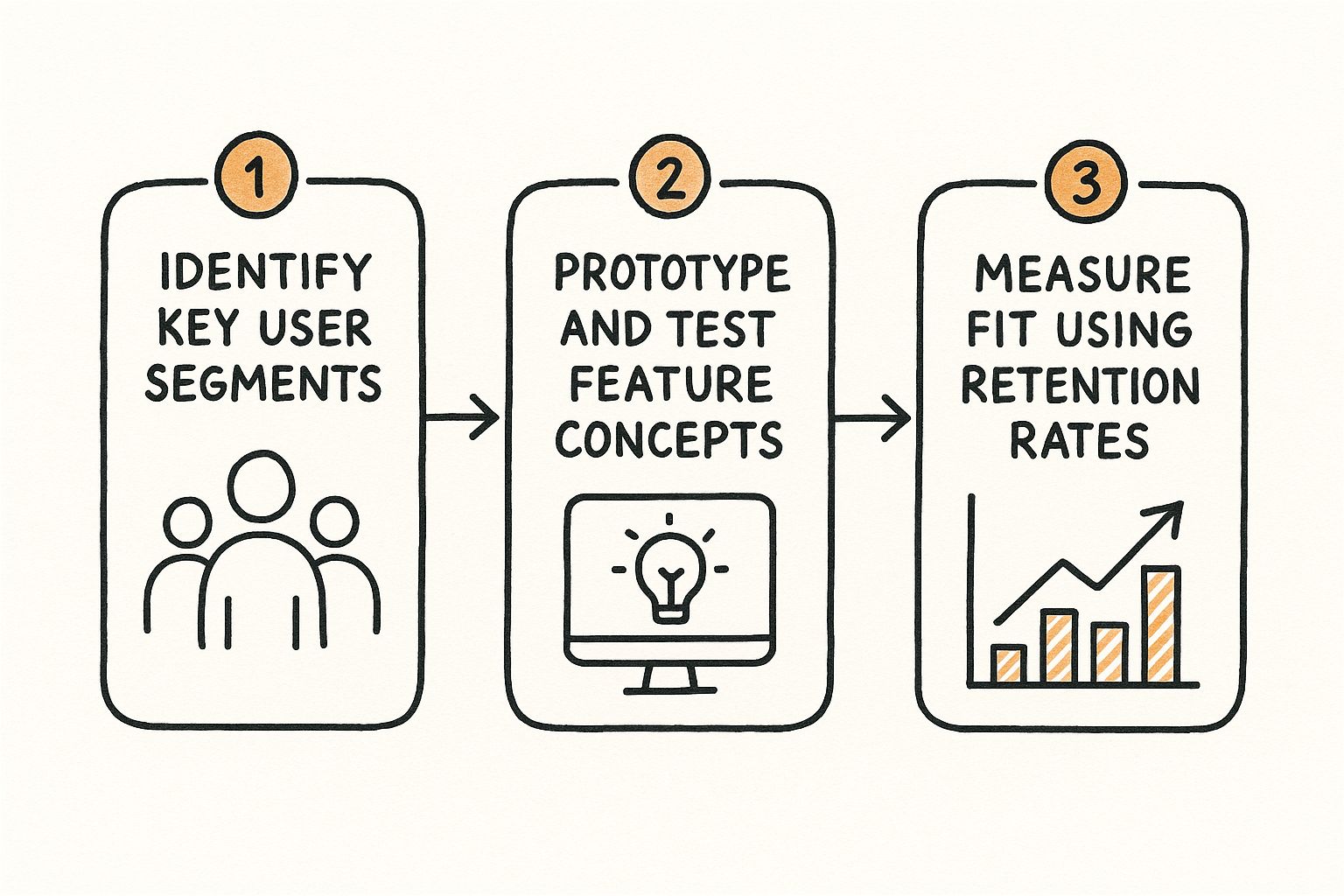Table of Contents
Understanding The Marketplace DNA: Building Your Foundation
Cracking The Chicken-And-Egg Code: Network Effects That Scale
B2B Marketplace Goldmine: The Overlooked Growth Engine
Building Trust and Credibility
Leveraging Unique Growth Levers
Experience Design That Converts: Psychology Meets Interface
Building Trust Between Strangers
Crafting Seamless User Journeys
The Psychology of Trust Signals
Growth Marketing That Actually Works: Beyond Basic Tactics
Referral Programs: Turning Users into Acquisition Machines
Content Strategies: Driving Organic Discovery
Partnership Approaches: Unlocking New User Segments
The Counterintuitive Truth About One-Sided Focus
Metrics That Predict Long-Term Success
Content Formats That Build Credibility
Partnership Strategies That 10x User Acquisition
Strategic Partnerships: Your Growth Multiplication Engine
Shopify's App Ecosystem: Turning Competitors Into Allies
Airbnb's Integrations: Expanding Your Reach
Identifying Win-Win Opportunities
The Art of Negotiation and Management
Practical Templates and Case Studies
Marketplace Metrics Mastery: Measuring What Matters
Beyond Vanity: Metrics That Matter
Measuring Network Effects in Action
Cohort Retention Curves and Lifetime Value
Building Data-Driven Dashboards
Understanding The Marketplace DNA: Building Your Foundation

This screenshot of Amazon's homepage shows its massive product selection and user-friendly design. But Amazon’s success isn't just about a slick interface. It's built on a deep understanding of what makes both buyers and sellers tick. Notice how prominently Amazon features seller tools and resources. This highlights their commitment to empowering sellers – a crucial part of their marketplace growth strategy.
Building a successful marketplace is like constructing a house. You need a solid foundation before adding walls, windows, and a roof. This means carefully planning the core components that will support future expansion. Think about Amazon. They didn't just focus on buyer convenience. They realized that seller success was equally important. This fostered a healthy ecosystem where both sides could thrive.
Balancing Supply and Demand
This balanced approach to supply and demand is essential. Imagine a dance floor: too many eager dancers (buyers) and not enough partners (sellers) creates frustration. Too many partners and not enough dancers leaves potential on the table. This balance is the magic that makes a marketplace work.
Understanding User Psychology
Understanding why users choose your platform over a competitor is also crucial. Is it price, selection, or a sense of community? Pinpointing these motivators and incorporating them into your marketplace design is like adding the right spices to a recipe – it makes all the difference.
Avoiding Common Pitfalls
Recognizing and avoiding common pitfalls early on can save you valuable time and resources. Many marketplaces stumble in their first year by overlooking fundamental elements. For instance, failing to define your value proposition, neglecting seller onboarding, or underestimating the importance of community building can quickly derail even the most promising ventures.
Ready to drive more growth & achieve bigger impact?
Leverage my 25+ years of successes and failures to unlock your growth and achieve results you never thought possible.
Get StartedTo help you visualize the foundational elements and their varying importance across marketplace types, take a look at the comparison table below:
Marketplace Foundation Elements Comparison Comparison of essential foundation elements across different types of marketplaces (B2C, B2B, C2C) and their implementation priorities.
| Foundation Element | B2C Priority | B2B Priority | C2C Priority | Implementation Difficulty |
|---|---|---|---|---|
| Defining Value Proposition | High | High | Medium | Medium |
| Seller Onboarding | High | Medium | Low | Medium |
| Community Building | Medium | Low | High | High |
| Supply/Demand Balance | High | High | Medium | High |
| User Experience (UX) | High | Medium | Medium | High |
| Secure Payments | High | High | High | High |
| Trust & Safety | High | High | High | High |
| Marketing & Promotion | High | Medium | Low | Medium |
This table highlights the different priorities for various marketplace types. For example, while user experience is crucial for B2C, community building might be more important for a C2C marketplace. Similarly, secure payments are a high priority across all types.
The Growth of E-commerce
The rise of global e-commerce underscores the importance of a strong foundation. In 2024, global retail e-commerce sales hit an estimated six trillion USD, with projections showing a 31% increase by 2028. This explosive growth emphasizes the need for marketplaces to enhance their digital platforms and expand their product offerings. Learn more about e-commerce growth.
By building a solid foundation, you set the stage for sustainable, long-term growth and create a marketplace that truly connects with your target audience.
Cracking The Chicken-And-Egg Code: Network Effects That Scale
Building a successful online marketplace often presents a classic dilemma: attracting buyers requires sellers, but sellers need a significant customer base to join. This is the crux of marketplace growth. It's not just about solving a problem, it's about mastering a specific sequence of steps. Platforms like Uber and Airbnb didn't achieve global dominance overnight. They strategically sequenced their growth, focusing on specific steps in order.

This screenshot shows the Uber app's simple interface, emphasizing ease of use. Uber’s initial success wasn't about world domination. It began by targeting a specific niche: black car service in San Francisco. This allowed them to build a dependable supply of drivers and gain initial traction within a controlled environment, validating their concept before expansion.
The Power of Niche Focus
Instead of trying to cater to everyone, Uber initially concentrated on a small, defined market. This allowed them to build a critical mass of both drivers and riders in a specific geographic location. Think of it like building a fire – you start with small kindling, not large logs. This concentrated approach creates a strong network effect, where the platform's value increases with each new user.
Incentivizing Early Adopters
Early adopters are essential for any new marketplace. They're willing to try your platform before it's established, and their loyalty is invaluable. Incentivizing these early users is critical. Uber used bonuses and promotions to attract both drivers and riders in the beginning. These incentives not only attract initial users, they encourage those users to become advocates, spreading the word and further fueling the platform's growth.

The infographic above illustrates a core process for driving marketplace growth: identify key user segments, test new features, and measure their impact on user retention. This process highlights the importance of iterative improvements and using data to inform decisions. By prioritizing user retention, marketplaces can identify what resonates with their audience and refine their offerings accordingly, leading to sustainable growth.
Measuring the Tipping Point
How can you tell when you've overcome the chicken-and-egg problem? It's all about tracking the right metrics. Retention rates are key. If users consistently return, your platform is providing real value. Etsy, for instance, focused on cultivating a passionate community of craft sellers and buyers. This tight-knit community became a self-sustaining growth engine. As more sellers joined, the platform attracted more buyers, and vice versa.
To help illustrate different approaches to this challenge, let's look at a few strategies, their potential success rates, and other factors to consider. The following table summarizes key approaches to activating network effects and overcoming the chicken-and-egg problem:
| Strategy | Success Rate | Time to Results | Initial Investment | Best For |
|---|---|---|---|---|
| Niche Focus | High | Short-Medium | Low-Medium | Early-stage marketplaces, specific communities |
| Incentivizing Early Adopters | Medium | Short | Medium | Launching new features, attracting initial users |
| Building a Community | Medium-High | Long | Low-Medium | Platforms centered around shared interests |
| Seeding the Marketplace (e.g., with bots) | Low | Short | Low | Jumpstarting activity, but risky long-term |
| Partnerships | Medium | Medium | Variable | Expanding reach, accessing new user groups |
As the table shows, there's no one-size-fits-all solution. The best approach depends on your specific marketplace and its target audience. Choosing the right strategy, combined with careful monitoring of key metrics, is crucial for sustainable growth.
B2B Marketplace Goldmine: The Overlooked Growth Engine

This screenshot of Alibaba showcases their vast B2B marketplace. Notice the wide range of product categories and the readily available supplier information. Alibaba's success story highlights the potential of focusing on B2B marketplace growth strategies. They've built a platform catering to businesses looking for suppliers and products globally, demonstrating a keen understanding of the nuances of B2B transactions. It's not about a flashy website; it's about providing practical functionality and access.
While consumer marketplaces are attractive, the B2B sector offers a compelling, often overlooked, alternative. B2B marketplaces operate differently. Think longer sales cycles, higher order values, and a strong emphasis on building trust. These are key distinctions. This isn't about enticing impulse buys; it's about nurturing lasting business relationships. For more on growth strategies, check out Matthew Mamet's blog.
Navigating the B2B Landscape
B2B buying decisions often involve several people and complex procedures. Imagine selling software to a large corporation. You're not just convincing one person; you're navigating a whole chain of stakeholders. This demands a different approach compared to consumer marketplaces, where individual decisions are the norm. Your platform needs to handle these intricate transactions and provide tools that support collaborative decision-making within businesses.
Building Trust and Credibility
Verification and credibility are paramount in B2B. A slick user interface won't persuade a business to invest significant capital. Focus instead on building trust. How? Through verified suppliers, secure transactions, and open communication. Consider the importance of supplier ratings and reviews on Alibaba. They build buyer confidence and mitigate risk. This emphasis on trust is fundamental to any successful marketplace growth strategy.
Leveraging Unique Growth Levers
B2B platforms have growth levers unique to their sector. Industry-specific features and targeted marketing resonate strongly with business buyers. Picture a marketplace designed specifically for the construction industry. Features like project management tools and material sourcing would be far more valuable than general marketing messages. This tailored approach unlocks significant growth.
Furthermore, understanding the psychology of business buyers is crucial. They prioritize efficiency, reliability, and a solid return on investment. This necessitates a different messaging and marketing approach compared to consumer-focused platforms. It means highlighting value creation and showing how your marketplace directly contributes to a business's goals.
The growth of the B2B e-commerce market underlines this opportunity. As of 2025, the market is valued at $32.11 trillion, with a projected CAGR of 14.5%, reaching $36.16 trillion by 2026. That's nearly 116% growth since the beginning of the decade. Find more insights on B2B e-commerce growth here. This explosive growth signals massive potential for marketplaces to adapt by offering specialized B2B services and leveraging technology to facilitate seamless transactions.
Experience Design That Converts: Psychology Meets Interface
Imagine browsing Airbnb, effortlessly finding the perfect vacation rental. That smooth experience isn't accidental. It's the result of carefully considered user experience (UX) design, built on principles of psychology and behavior. Every element, from the placement of images to the flow of the booking process, is designed to guide your decisions and build trust. This section explores the art of designing interfaces specifically for the complex world of online marketplaces.
Building Trust Between Strangers
Marketplaces differ from traditional e-commerce because they connect strangers. This introduces a unique challenge: fostering trust. Think about the difference between buying a book from Amazon and commissioning a portrait from an artist on Etsy. The latter requires a much greater leap of faith.
Marketplaces must facilitate complex transactions, often involving significant sums of money or personal services, all while balancing the needs of multiple user groups. This necessitates a focus on transparency and security.
Consider this screenshot from Etsy. The prominent display of seller profiles and product reviews serves a vital purpose: it builds trust. By humanizing sellers and providing social proof, Etsy bridges the gap between buyers and sellers, even when they're separated by thousands of miles.
Crafting Seamless User Journeys
Successful marketplaces meticulously map user journeys, eliminating friction and adding moments of delight. Lyft's booking process, with its simplicity and real-time tracking, is a prime example. The experience reduces anxiety and builds anticipation, turning a mundane task into something almost enjoyable.
Similarly, Etsy's discovery algorithms connect buyers with unique, personalized products, creating a sense of serendipitous discovery. In the B2B world, user experience priorities shift towards efficiency. Think streamlined procurement processes and readily available, detailed product information. Applying principles from resources like this article on Social Selling Strategies For B2b Sales can greatly enhance the B2B marketplace experience.
Onboarding for Engagement
Effective onboarding is the key to converting casual visitors into active community members. A clear, guided onboarding process minimizes confusion and encourages early engagement. This might involve personalized product recommendations, introductions to other users, or step-by-step tutorials for key platform features. The ultimate goal is to quickly demonstrate value and integrate new users into the marketplace ecosystem.
The Psychology of Trust Signals
Understanding trust signals is crucial for marketplace growth. These signals, such as user reviews, verified seller badges, and secure payment gateways, play a significant role in mitigating uncertainty and encouraging transactions. They serve as indicators of reliability and security, making users feel more comfortable interacting within the marketplace. A platform's success often hinges on its ability to cultivate and maintain this trust.
Designing Magical Discovery
Creating a search and discovery experience that feels intuitive and inspiring is essential for driving user engagement and repeat visits. This involves intuitive search filters, personalized recommendations, and visually appealing product displays. Think about how Spotify suggests new music based on your listening history. This personalized approach elevates the user experience and keeps users coming back for more.
This section underscores the vital role of psychology in interface design. By understanding user motivations, behaviors, and the power of trust signals, you can create marketplace experiences that are not only functional but also engaging and enjoyable, driving conversion and, ultimately, growth.
Growth Marketing That Actually Works: Beyond Basic Tactics

This screenshot from Fiverr shows how they categorize services and highlight freelancer profiles. It emphasizes discoverability, a key element of marketplace growth. By making it easy for buyers to find specific skills and vet freelancers, Fiverr encourages transactions and boosts platform engagement.
Traditional marketing is all about getting new customers. But marketplace growth requires a different mindset. Successful marketplaces don't just acquire customers; they ignite network effects. Think of it like a snowball rolling downhill, gaining momentum and size as it goes. These viral loops create organic, compounding growth. This section explores the tactics that really drive that kind of growth. For a deeper dive, check out Matthew Mamet's framework for growth.
Referral Programs: Turning Users into Acquisition Machines
Referral programs turn happy users into your best marketers. Think about how DoorDash used referrals. They rewarded existing users for bringing in new customers, creating a self-sustaining growth cycle. This strategy taps into pre-existing trust, making new user acquisition more efficient and cheaper.
Content Strategies: Driving Organic Discovery
Content marketing is key for attracting users organically. Fiverr's content strategy, for instance, focuses on providing valuable resources for freelancers and businesses. This attracts traffic through search engine optimization (SEO) and positions Fiverr as a thought leader. By addressing the needs of their target audience, they attract both buyers and sellers naturally.
Partnership Approaches: Unlocking New User Segments
Strategic partnerships can open doors to entirely new user groups. Imagine a fitness marketplace teaming up with a nutrition app. Suddenly, both platforms are exposed to a wider audience, creating a win-win situation. Partnerships can dramatically expand your reach and introduce your marketplace to people who might never have found you otherwise.
The Counterintuitive Truth About One-Sided Focus
Many marketplaces aim for perfect balance between buyers and sellers right from the start. But here’s a counterintuitive truth: focusing on one side first can actually speed up overall growth. Picture a dating app launching with mostly female users. This attracts more men, quickly balancing the platform and creating a better experience for everyone.
Metrics That Predict Long-Term Success
Measuring the right things is crucial. User registrations might look good on paper, but they don't tell the whole story. Transaction volume, repeat purchase rates, and customer lifetime value are much better indicators of long-term health and success.
Content Formats That Build Credibility
Trust and credibility are vital for marketplace growth. Certain content formats work particularly well here. Case studies, testimonials, and expert interviews show real-world success stories and build confidence in your platform. Tools like a Testimonial Generator can help you create compelling testimonials that convert. These authentic stories resonate with potential users far more than generic marketing copy.
Partnership Strategies That 10x User Acquisition
The right partnerships can be game-changers. Teaming up with complementary businesses or influencers gives you access to existing networks and dramatically increases your reach. A well-executed partnership can quickly multiply your user base, injecting a surge of new activity into your marketplace. This is often much more effective than traditional marketing. By joining forces, you create a powerful growth engine that benefits everyone.
Strategic Partnerships: Your Growth Multiplication Engine
This screenshot from Shopify's partner page showcases the incredible variety of apps and experts they've assembled. It's a powerful illustration of how Shopify isn't just selling software; they're cultivating a thriving ecosystem that directly fuels their marketplace's growth. They've smartly transformed potential competitors into valuable collaborators, generating a powerful network effect.
Sometimes, the fastest way to expand your marketplace isn't by building every single feature yourself. It's about strategically choosing the right partners to propel your journey forward. Think of it like a relay race. You're not trying to run the entire race solo. Instead, you're strategically passing the baton to specialized teammates who can cover their leg of the race with greater speed and efficiency. This section explores how smart partnerships can become potent growth multipliers.
Shopify's App Ecosystem: Turning Competitors Into Allies
Shopify didn't attempt to build every single feature imaginable. Instead, they wisely created an app ecosystem that empowers third-party developers to create specialized tools. This brilliant strategy transformed potential rivals into valuable allies. These partners not only enrich Shopify's functionality, they also attract new merchants to the platform. It's a prime example of turning a potential threat into a strategic advantage.
Imagine a bustling marketplace with various specialized stalls. That’s what Shopify’s app ecosystem is like. Each app adds a unique offering, catering to specific merchant needs and ultimately enriching the entire marketplace.
Airbnb's Integrations: Expanding Your Reach
Airbnb strategically partnered with booking platforms, effectively opening up entirely new distribution channels. This smart move allowed them to reach travelers they might not have encountered otherwise. These integrations seamlessly connect different parts of the travel ecosystem, expanding Airbnb's reach and adding value for both guests and hosts.
Think of Airbnb's partnerships as bridges connecting different islands of travelers. Each bridge extends their reach, bringing in new guests and offering more choices to existing ones.
Identifying Win-Win Opportunities
Successful partnerships hinge on mutual benefit. Both sides should gain something valuable from the collaboration. This necessitates a clear understanding of each partner's strengths and goals. Think of it as a successful negotiation: everyone walks away feeling satisfied with the outcome.
Consider leveraging AI to enhance your growth marketing. For example, explore the possibilities of AI marketing automation. This kind of cross-pollination can unlock unexpected growth avenues.
The Art of Negotiation and Management
Negotiating partnership deals is a delicate art. It requires clear communication, transparency, and a focus on building long-term value. Just like a healthy relationship, partnerships need consistent nurturing and management.
As your marketplace evolves, so should your partnerships. Regular communication and adjustments are crucial to ensuring both sides continue to reap the benefits.
Avoiding Partnership Pitfalls
Not all partnerships are destined for success. Sometimes, misaligned goals or communication breakdowns can transform a promising alliance into a costly mistake. Clearly defining expectations, roles, and responsibilities upfront is crucial. Regular check-ins and open communication can help prevent these pitfalls and ensure the partnership stays on track.
Practical Templates and Case Studies
This section offers practical resources to help you build successful partnerships. Templates for partnership agreements provide a solid foundation for defining terms and expectations. Detailed case studies offer real-world examples of how strategic alliances have transformed growth trajectories. These resources equip you with the tools and knowledge you need to forge partnerships that truly act as growth engines.
By embracing the power of collaboration, you can significantly accelerate your marketplace's growth and achieve success faster than going it alone. Strategic partnerships aren't just beneficial; they're often essential for reaching your full potential in the competitive marketplace landscape.
Marketplace Metrics Mastery: Measuring What Matters
Imagine boasting about thousands of registered users on your marketplace. Sounds impressive, right? But what if those users are just lurking, not actually buying or selling anything? It's like having a stadium full of empty seats – looks big, but generates no revenue. Traditional business metrics often miss the unique dynamics of online marketplaces. We need to go deeper than vanity metrics to understand what truly fuels growth.
Beyond Vanity: Metrics That Matter
Instead of obsessing over registrations, smart marketplace operators look at metrics that reflect real activity and value. Transaction volume tells you how much business is actually being conducted on your platform. It's the equivalent of ticket sales at our stadium. Repeat purchase rates reveal how well you're keeping customers coming back for more, like season ticket holders. Customer Lifetime Value (CLTV) helps you understand the long-term revenue potential of each customer. These metrics paint a much clearer picture of your marketplace's health.
Measuring Network Effects in Action
Network effects are the engine of any successful marketplace. They're the reason why a busy marketplace attracts even more buyers and sellers, creating a virtuous cycle. But how do you measure this momentum? The supply-demand balance ratio is key. It shows how effectively your platform is connecting buyers and sellers. Think of it as the perfect ratio of performers to audience members. Another crucial metric is the time to transaction. A shorter time indicates a frictionless marketplace, encouraging more frequent transactions. It's like minimizing the lines at the concession stands.
Cohort Retention Curves and Lifetime Value
Cohort retention curves offer valuable insights into user behavior over time. By tracking how long different groups of users stay active, you can pinpoint areas for improvement. Imagine analyzing how different groups of fans engage with a sports team over the season. Lifetime value calculations help you understand the long-term financial impact of acquiring and retaining users. This information can inform your marketing and customer acquisition strategies, much like a team invests in attracting and retaining fans.
This screenshot from Upwork's website showcases their focus on connecting businesses with freelancers. Notice how prominently they display freelancer profiles and skill categories. This emphasis on connecting supply and demand is a cornerstone of marketplace success.
Upwork's clear presentation of freelancer profiles and skills reflects their understanding of marketplace dynamics. By making it easy for businesses to find talent, Upwork creates a win-win ecosystem. This aligns perfectly with the principle of balancing supply and demand.
Building Data-Driven Dashboards
Effective dashboards are like the control panel for your marketplace. They provide a real-time view of performance. These dashboards should include both leading indicators, which predict future performance, and lagging indicators, which show past results. Leading indicators might include user engagement metrics like average session duration and number of listings viewed. Lagging indicators include financial metrics like revenue and profit. By monitoring these indicators, you can proactively address problems and seize opportunities.
Leading vs. Lagging Indicators
Think of leading indicators as your marketplace's early warning system. They give you a heads-up about potential issues before they escalate. Lagging indicators, on the other hand, confirm the effectiveness of your strategies and measure past performance. Tracking both gives you a complete understanding of your marketplace's trajectory.
Measurement Frameworks for Sustainable Growth
Different measurement frameworks offer distinct perspectives on marketplace performance. The AARRR framework (Acquisition, Activation, Retention, Referral, Revenue) helps you optimize the entire customer journey. The North Star Metric framework encourages you to focus on a single key metric aligned with your overall business goals. Choosing the right framework depends on your specific marketplace and its stage of development. These frameworks provide a structured approach to measuring success and guiding your growth strategies.
Ready to take your marketplace to the next level?
Ready to drive more growth & achieve bigger impact?
Leverage my 25+ years of successes and failures to unlock your growth and achieve results you never thought possible.
Get Started

